Amour - en - Cage
Glass, resin, crystals, light - Variable dimensions
This 'lantern fruit' has became a recurring motif emblematic in its symbolism and tied to my personal mythology. Highly toxic when unripe, the fruit transforms itself into a medicinally potent botanical on maturity. Known in France as Amour-en-cage, literally translating as "Love in a cage", I have always been enamored by the symbolism of a soft warm glowing energy centre growing to maturity within the protective/restrictive cocoon of its calyx/cage/lantern. This glowing fruit, beautifully bulbous, shiny, glossy and potent with possibility, juxtaposed against its broken, shedding veiled husk. The duality of veil/reveal giving way to something so otherworldly brilliant and bright at its centre gives the fruit a quality analogous to the transformation of the heart that is as much a spiritual transformation as it is a physical one.

Mixed media sculpture
The Garden of Eleusis
Glass, resin, crystal, cold cast bronze, sugar paste, cold porcelain, wood, pigments, almonds, candied fruit
100 cm x 100 cm x 140 cm
The Garden of Eleusis
Glass, resin, crystal, cold cast bronze, sugar paste, cold porcelain, wood, pigments, almonds, candied fruit
100 cm x 100 cm x 140 cm
The Garden of Eleusis
The Garden of Eleusis - Detail
The Garden of Eleusis - Detail
Appearing as an abundant Cornucopia, ‘The Garden of Eleusis’ calls forth an emotive sensual language of botanical symbolism.
Inspired by a longtime fascination with the Eleusinian mystery school of ancient Greece the sculpture has been conceived in the spirit of the great ‘Mysteries’, in particular the agrarian Cult of Demeter and Persephone, it's associations with descent and ascent, rebirth, abundance, nourishment, gnosis, and spiritual wealth.
Employing a visual language and materiality that reference entheogenic practices alongside the culinary arts, fine arts and folk crafts, the contents of the garden have all been chosen for associations bound to their materiality along with narratives that have emerged from the Sanctuary of Eleusis and associated ‘Mysteries' from further afield.
Objects for re-enchantment

An offering to Quetzalcoatl
Ceremonial edible
An Ode to Aurora- The Saffron Mother
Saffron stigmas, sugar rachis, saffron essential oil. Saffron sourced from: Norfolk Saffron
Book 19 of The Iliad
[1] Now Dawn the saffron-robed arose from the streams of Oceanus to bring light to immortals and to mortal men.
Wings of Desire
Chocolate, fondant, essential oils of; pomegranate; saffron; violet and rose, sugarpaste, wood, flowers, moss, pigments, gold leaf
“To possess wings, is to be deeply implicated in the workings of desire.”
Persephone’s Bluebird
Chocolate, fondant, pomegranate essential oil, sugarpaste, pigment, gold leaf, cupcake, plate
Portrait of an Artist - Wild at Heart and Weird on Top
Glass, resin, crystals, top-hat, printed fabric, paint
The Accomplished Cook
“Which of mathematics doth pertake, Geometry proportions when they bake. Who can in paste erect (of finest flour), A compleat Fort, a Castle, or a Tower”
Chocolate mousse, biscuit tuille, spiced ganache, lemon peel, plate
Installation

Candyland
Edible installation
110 cm x 244 cm x 122 cm
Candyland, a playful exposition on taste, aesthetics, wealth, power and desire. Formally ostentatious and OTT the installation plays with notions of both beauty and the aesthetic grotesque. Using a visual language so embedded within the collective consciousness, Candyland appears as a disarmingly innocent and familiar apparition, ready loaded with a sense of uncanny.
Sugar after all is not all sweetness and light and all things nice. At once pleasure and joy, whilst simultaneously saccharine and cloying. Extrapolate further and sugar becomes conquest, power, geopolitical dominance, wealth, addiction, decadence and excess.
Civilisations have been built on sugar. The temporal, performative and time-based nature of the installation suggests a civilisation destined to fall too. It’s classically styled pavilion and surrounding pleasure gardens heaving with an excess of sweet treats. A ransacking by greedy hands seems inevitable. A decadent act of destruction by the hungry ghosts who conversely celebrate and covet this candy-coated land.
The installation is thus designed to simultaneously invoke both a sense of attraction and repulsion. An entertaining, frivolous and fun edible spectacle in which to indulge whilst ‘Rome burns’. A comment on the compulsions of a consumerist society, bourgeois decadence, ecological disaster and the existential threat of impending civilisational collapse at the fate of our own hands.
Candyland - detail
Candyland - detail
Candyland - detail
Candyland - detail
Print Making for the Time Being.
u (existence, being),
ji (time)
In the Soto school of Zen Buddhism, Uji (有時) is a concept best translated as ‘Time-Being’ or ‘Being-Time’.
Uji is the understanding that Being-Time is sentience and sentient beings are Time-Beings.
The Art of Being Uji is thus the conscious art of Being a Time Being.
In the Zen forms we meditate on the states of Uji.
Within, without and formed by time, Uji is; transient yet timeless, form and formlessness.
Paper and ink become moon and stars. Flowers, mountains and rivers become sentient beings. The printed page a floating world.
Silkscreen Prints
Aurora over Agua
Fuego
Moonflower
Drawings

Visualising Phosphenes
Phosphene studies
From fos + phene; from Ancient Greek φῶς (phôs, “light”) + φαίνω (phaínō, “to appear, shine”)
Further developed from my ‘Psychic Cartography’ drawing project, ‘Visualising Phosphenes’ has been a process of bringing light to the Entoptic Visions I’ve had since a child.
As long as I can remember I’ve had this intimate relationship with the phenomena of Phosphenes and as a young child I would gently massage my eyes through my eyelids to marvel at the display of shifting form and colour.
The word phosphene comes from the Greek words phōs (light) and phainein (to show). From a contemporary western cartesian perspective, Phospenes are best describes as a:
“subjective images experienced in the absence of external visual stimuli and having their origin within the eye and brain; their patterns seem to be "intimately related to the geometry of the eye, the visual pathway and the visual cortex"
Beyond this biological Eurocentric definition, in many indigenous wisdom traditions it is believed that phosphenes have a much greater biopsychosocial-spiritual significance.
From the position of art history, it has been suggested that many non-figurative art forms, starting with the pictographs and petroglyphs of the first people, feature depictions of the neurological form constants consistent with the shapes and forms of phosphenes. Whether experienced through altered states of consciousness induced by entheogens, meditation, dance, trance, hyperventilation, sensory deprivation, hypnagogia or other means, it seems likely that our oldest recorded evidence of this universal visual phenomena was first produced for magico-religious purposes and recorded as an expression of these internal states and shamanistic experiences.
Psychic Cartography
I AM LARGE, I CONTAIN MULTITUDES. 1.
I AM LARGE, I CONTAIN MULTITUDES. 2.
I AM LARGE, I CONTAIN MULTITUDES. 3.
I AM LARGE, I CONTAIN MULTITUDES. 4.
I AM LARGE, I CONTAIN MULTITUDES - Detail. 1.
I AM LARGE, I CONTAIN MULTITUDES - Detail. 2.
Through a process of automatic mark making, I repeatedly draw simple organic forms, variants on each other, their individual characteristics unique whilst familiar and self-referential. I use these forms as my material, composites knitted together to describe form and movement. Over time a meandering sprawl emerges, informed by a set of re-generative principles, its condition is one that speaks to the notion of multiplicity and unity held intimately in a state of interdependence.
There is a dichotomy of freewill and determinism that I engage with in the making of these works. Through observation of my process new variables are suggested, some explored, others dismissed until a firm set of physical laws becomes established. These laws are unique to each composition, defining the process of organisation and determining the final structure of each composition.
I view the resulting compositions as destinations, entities that embody a line of enquiry. These entities reveal themselves somewhere in a space between the conscious and unconscious, the intuitive and the prescribed, the natural world and the otherworldly, in the push and pull present within the dichotomies of my process.
A Sense of Unity
Hand drawn colourfield animation